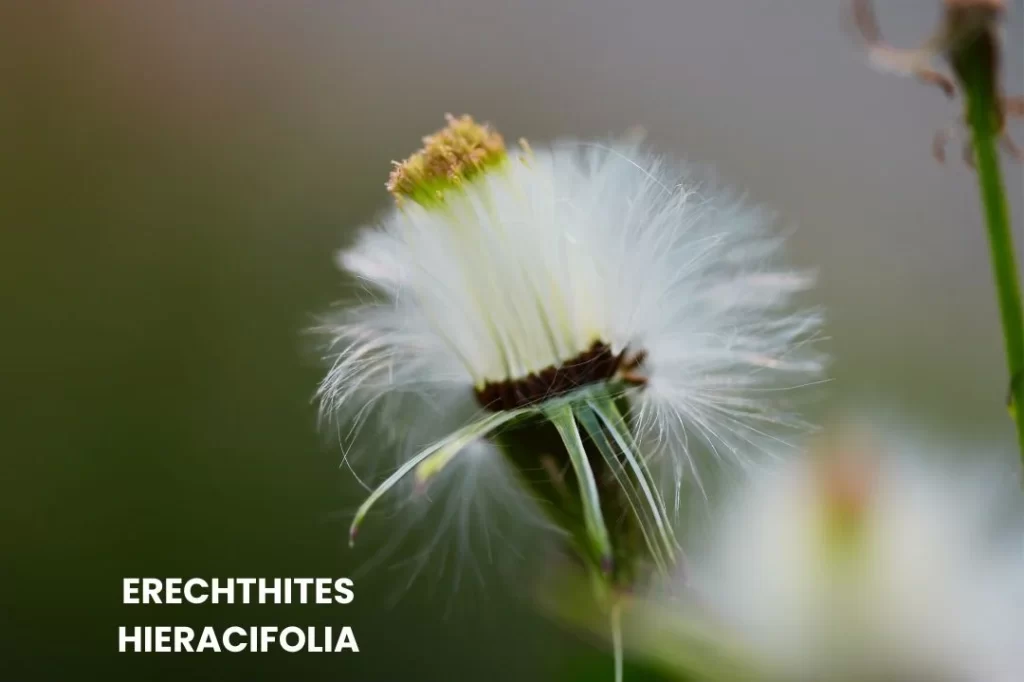Erechthites hieracifolia, commonly known as Fire-weed or American Burnweed, is an annual herb native to North America.
This robust plant, often found in disturbed soils and areas recently affected by fire, has a long history of medicinal use among Native Americans and early settlers.
In homeopathy, Erechthites hieracifolia is renowned for its potent hemostatic properties, effectively treating various types of bleeding, circulatory disturbances, and skin conditions resembling poison ivy reactions.
This remedy also addresses urinary issues and edema, making it a versatile addition to the homeopathic pharmacopeia.

Table of Contents
ToggleSOURCE INFORMATION
Common Names: Fire-weed, American Burnweed
Scientific Classification
- Kingdom: Plantae
- Clade: Angiosperms
- Clade: Eudicots
- Order: Asterales
- Family: Asteraceae
- Genus: Erechthites
- Species: Erechthites hieracifolia
Origin and Distribution
Erechthites hieracifolia, commonly known as Fire-weed or American Burnweed, is native to North America.
It thrives in disturbed soils, such as those found in areas recently affected by fire, which is how it earned the name Fire-weed.
It is commonly found in fields, forest clearings, and alongside roads.
Description
- Plant Description: This annual herb can grow up to 2 meters in height. It has a robust, hollow stem that may be green or slightly reddish.
- Leaves: The leaves are lance-shaped with serrated edges, and they are arranged alternately along the stem.
- Flowers: The plant produces small, white to pale yellow flowers in clusters. The flowers are followed by fluffy seed heads that aid in wind dispersal.
Historical and Medicinal Uses
- Traditional Uses: Native Americans and early settlers used Fire-weed for its medicinal properties, particularly for treating wounds and as a remedy for respiratory and digestive issues.
- Homeopathic Uses: In homeopathy, Erechthites hieracifolia is primarily used as a hemorrhagic remedy, effective in treating various types of bleeding and circulatory issues.
Medicinal Properties and Indications
- Haemorrhage: It is used to treat bleeding from various parts of the body, including the nose (epistaxis) and lungs, characterized by bright red blood. The bleeding is typically accompanied by an excited state of the circulatory system.
- Flashes of Heat and Coldness: The remedy addresses sudden sensations of heat followed by coldness.
- Urinary Issues: It helps with scanty urine output and edema (swelling) of the extremities.
- Skin Conditions: Symptoms similar to those caused by Rhus poisoning (poison ivy) can be alleviated with this remedy.
KEY SYMPTOMS
- Nosebleeds (Epistaxis): Bright red blood from the nose.
- Lung Hemorrhage: Bleeding from the lungs, accompanied by circulatory excitement.
- Heat and Cold Flashes: Alternating sensations of heat and coldness.
- Edema: Swelling of the extremities due to fluid retention.
- Skin Irritation: Skin symptoms resembling poison ivy reactions.
MODALITIES
- Worse: Symptoms may worsen with physical exertion or emotional stress.
- Better: Relief may come from rest and avoiding exposure to known irritants.
WHAT ARE MODALITIES IN HOMOEOPATHY?
RELATIONSHIP WITH OTHER REMEDIES
Compare With:
- Erigeron (Erig): Another hemorrhagic remedy used for bleeding from various parts of the body.
- Millefolium (Millef): Known for treating hemorrhages and varicose veins.
- Hamamelis (Hamam): Used for treating venous congestion and bleeding.
- Rhus Toxicodendron (Rhus): Effective for skin conditions and allergic reactions similar to those caused by poison ivy.
DOSE
- Homeopathic Tincture: The tincture can be used internally for systemic conditions and externally for skin issues like poison oak reactions.
Frequently Asked Questions
What is Erechthites hieracifolia used for in homeopathy?
- It is used for treating hemorrhages, circulatory issues, urinary problems, and skin conditions.
How is Erechthites hieracifolia administered?
- It is typically administered in tincture form, either internally or applied externally for skin issues.
Can Erechthites hieracifolia help with poison ivy reactions?
- Yes, it can be used locally to treat skin symptoms similar to those caused by poison ivy.
Glossary of Difficult Words
- Epistaxis: Nosebleed.
- Hemorrhage: Excessive bleeding.
- Edema: Swelling caused by fluid retention.
- Circulatory Excitement: Increased activity of the circulatory system.
- Scanty: Insufficient or minimal.
- Tincture: A solution of a medicinal substance in an alcoholic solvent.
- Subinvolution: The failure of an organ to return to its normal size after enlargement, commonly used in reference to the uterus after childbirth.
Erechthites hieracifolia is a valuable remedy in homeopathy, particularly for its effectiveness in treating hemorrhages, circulatory disturbances, and certain skin conditions.
